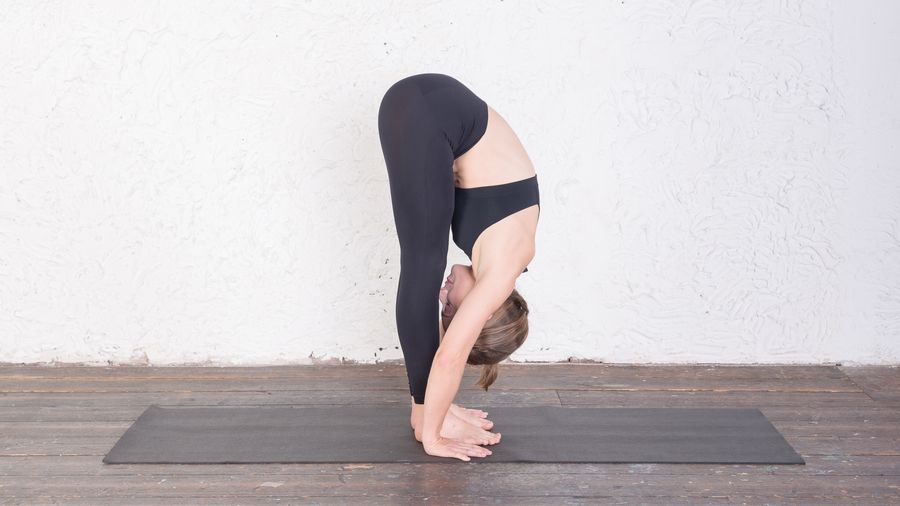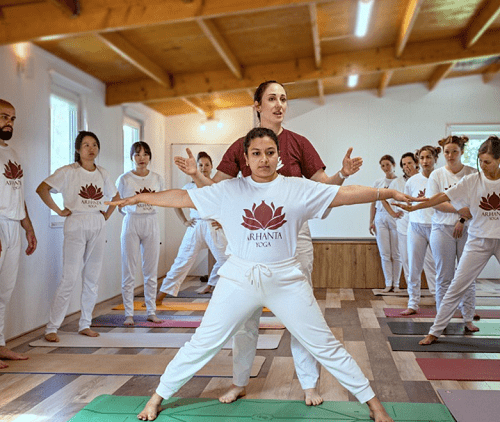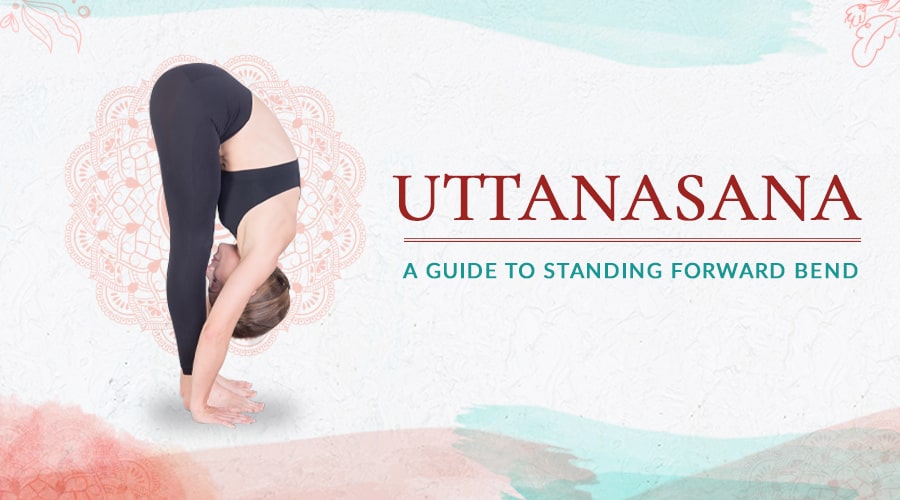Uttanasana or Standing Forward Fold (or Bend) may be one of the first poses learned by a beginner. It features in Sun Salutations (Surya Namaskar) and is used in many styles of yoga practice including Hatha Yoga, Vinyasa Yoga and Ashtanga Yoga.
If practiced without good teaching advice, Uttanasana can easily be misunderstood and practiced incorrectly. It’s not about touching your toes. If you understand the intention of the pose, you will be more comfortable in it - and receive more benefits.
What is Uttanasana
Uttanasana is a Sanskrit word. The ending ‘asana’ identifies it as the name of a yoga pose. The beginning of the word is made up of two parts - ut and tan. Ut means intense or deliberate, and tan means to stretch or to lengthen.
Uttanasana therefore means a strong and intentional stretch. In bending forward, we stretch the back of the body. Sometimes people assume the stretch is simply for the hamstrings, but the pose involves body tissues from head to heels.
The Standing Forward Bend is thought to have evolved from the even older seated forward fold. Uttanasana in standing has been widely practiced for generations and is described in many yoga texts including books by Krishnamacharya, B. K. S. Iyengar and Pattabhi Jois.
Benefits of Uttanasana
The lengthening and stretching benefits of Uttanasana are easily felt in the pose. The structures benefiting from the stretch include
- Erector Spinae (back muscles alongside the spine)
- Gluteal muscles (butt)
- Hamstring muscles (back of thigh)
- Small deep muscles of the hip and spine
- Fascia of the back body, particularly the thoracolumbar fascia
Allowing the head and arms to hang relaxed in Uttanasana may help relieve neck and shoulder tension and stiffness, and ease headaches.
The forward folded position can also help by massaging the abdominal muscles and decompressing the spinal vertebrae.
The forward fold position also stimulates the sacral or Svadhishthana Chakra. This Chakra governs sexuality, desires, and pleasures and is associated with the element of water and the act of procreation. Stimulating and balancing the flow of energy at this Chakra may assist with the function and health of the urinary tract, kidneys, testes and ovaries.
Cautions for Uttanasana
Trying to force your body into a deep forward bend can cause serious injuries. While adjustments by an expert teacher might help you find a suitable and safe position, no-one should ever push you further into a stretch position. You should also avoid focusing on getting your nose to your shins, or your hands to the floor.
Safe forward folds focus on tilting the pelvis forward to the degree available to your individual anatomy. For more information on how to be safe in all your forward folds, please read our Guide to Safe Yoga Forward Bends.
Practicing Uttanasana in a form that suits your body will make it quite safe for most people. However, you should seek medical advice before practicing inverted (upside down) poses if you have
- Hypertension
- Glaucoma or detached retina
You should also take extra care to avoid stressing sensitive tissues if you experience
- Lower-back pain
- Spinal issues or sciatica
- Hamstring injury
Please remember that although back pain should be treated with care, yoga can also be a useful tool for managing and relieving chronic back pain.
How to practice Uttanasana

Uttanasana Pose
Follow these steps to achieve a beneficial Uttanasana:
- Stand on your mat, with your feet together or hip width apart.
- Breathe out and bend forward from the hip joints, not from your waist.
- Reach your palms or fingertips toward the floor slightly in front of or beside your feet. Knees may be straight or bent.
- With each inhalation in the pose, lift and lengthen the front torso just slightly; with each exhalation release a little more fully into the forward bend.
- Hold steadily as long as is comfortable, breathing evenly.
To come out of the pose, bend your knees until your torso touches your thighs. Then press your heels into the floor and gently roll your spine upward. Your shoulders and head should come up last.

Experience authentic Hatha Yoga
Get free access to exclusive guided lessons with master teacher Kalyani Hauswirth-Jain
Improving your Uttanasana - advanced tips
- Remember this pose is NOT about touching your toes. The goal is anterior pelvic tilt - hinging forward from the hips.
- Focus on lengthening the front torso rather than curving it in towards the legs.
- Press your heels firmly into the floor.
- Lift your sitting bones toward the ceiling.
- Turn the tops of your thighs slightly inward.
- Let your head hang relaxed.
Modifications for Uttanasana
- If you need a seated practice, try seated forward bend (Paschimottanasana)
- If your hamstrings are tight or you feel strain in your lower back, bend your knees slightly.
- Try bending the knees more and resting the chest along the front of the thighs while you are folded forward.
- More support can be found by using blocks or firm cushions to bring the floor up to meet your hands. Press your hands into these supports to create straight back while keeping the pelvis tilted forward (hinged forward from the hips).
- Try practicing the pose with your feet hip-width apart to create more space.
- Instead of placing your palms on the floor you can hold the backs of your ankles.
- Try crossing your forearms and holding your opposite elbows, and let your arms hang relaxed along with your head.
Variations for Uttanasana
After bending forward, hold on to your big toes. With an inhalation, straighten your arms and lift your front torso away from your thighs, making your back as concave as possible. Then breathe out as you lengthen down and forward, bending your elbows out to the sides. Draw your shoulder blades away from your ears and reach with the crown of your head toward the floor.
After bending forward into Uttanasana, slide your hands underneath the soles of your feet, with the backs of your hands against the floor. Lift and lower your torso with your breath, as described for Big-Toe Pose above.
Come into a Standing Forward Bend, with your feet hip-width apart. Place your right hand in between your feet on the floor, and your left hand along the outer edge of your left foot. Shift your weight to your left foot, and, with an inhalation, raise your right leg back and up toward the ceiling. Firmly press your hands into the floor while reaching the ball of your right foot up and out. Reach with your nose toward your left knee or shin.
Release your right foot down to the floor and repeat on the other side.
In a Standing Forward Bend, hold on to your right big toe with your left hand and hold your left big toe with your right hand (right arm is crossing above your left arm). Breathe in and lengthen your spine, gently pulling your crown toward the floor. Breathe out and twist your upper body to your right. Look under your right arm to the ceiling, and reach with your left elbow toward the outside of your right knee or shin.
Repeat on the other side, with your left arm above your right arm, twisting to your left.
Uttanasana Summary
Standing Forward Bend is one of the most common asanas in yoga practice, popular in many styles and sequences. It should be modified and practiced as an intentional stretch to the tissues of the back-body, with an emphasis on folding forward at the hips. There are many useful modifications to help you achieve this forward pelvic tilt and access the intended benefits of the stretch.

Experience authentic Hatha Yoga
Get free access to exclusive guided lessons with master teacher Kalyani Hauswirth-Jain

